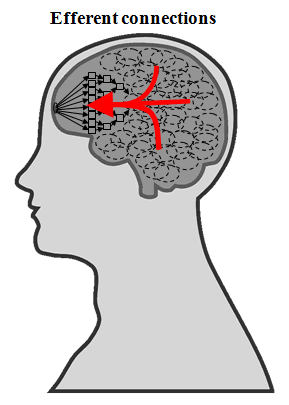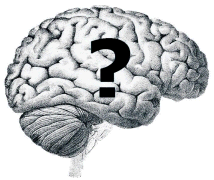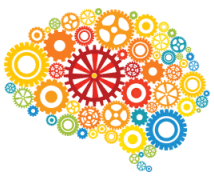Efferent connections
Efferent connections (“efferent” meaning “conducting outwards”) is my term to describe
the synapse connections between neurons that allows a flow of signals in the opposite direction
from the direction of incoming data signals that are processed by the brain.
The afferent processing (“afferent” meaning “conducting inwards”)
of incoming sense data and data from processes within the brain is a hierarchical and recursive coincidence detection process
that results in the creation of symbol schemas,
but the same process also results in the creation of, or strengthening of, connections in the opposite direction,
as shown in my afferent processing examples.

- As recently as the early 1990s, very little was understood about efferent connections in the
cerebral cortex.
It was known that there were many, but their purpose was not understood and they tended
to be ignored1,
2.
- It is now known that that there are at least as many efferent connections than afferent ones in the
sensory cortices, and possibly many
more2,
but I have yet to see a list in one place of all their possible
uses3.
- As with afferent (inwards) connections, many low-level efferent (outwards) connections
are probably built during brain development governed by the genetic blueprint in DNA.
- As pointed out in the “Naming” section on the afferent processing page, these connections have been given different names by different people and are variously called “backward”, “top-down”, “reciprocal” etc., which can be very confusing.
- I believe that there are (at least) seven different but related high-level brain functions that require efferent connections, and that they share the same (or very similar) pathways:
- Prediction is the ability of the brain to
predict signals that have either yet to come in via the senses or are missing from the data coming from the senses. To do this, there needs to be a process of matching incoming data with data that is already compressed and stored (memorised, if you like) in symbol schemas and the connections between them, and this is done using efferent connections. This applies to all sense data, both relating to external senses and internal senses.
- Reinstatement is the term I prefer to describe the reactivation via efferent connections of sensory neurons that were active when a symbol schema was being created or updated whenever that symbol schema is activated. Reinstatement is the only way that symbol schemas actually have a meaning for us.
- Action is the ability of the brain to initiate signals that ultimately cause the movement of muscles in the body. For many actions, the only way that the brain can know exactly what actions to take in a particular circumstance is by prediction based on previous experience, which requires efferent connections.
- Perception uses reinstatement via efferent connections to reinstate memories of past experiences, feelings and emotions related to the thing being perceived. This means that all perception is always affected by previous knowledge and experience.
- Attention uses efferent connections from the self symbol schema to an ordinary symbol schema and potentially from there to sensory neurons via reinstatement, which also uses efferent connections.
- Thought and imagination uses attention on
existing symbol schemas with reinstatement to recall
old memories and experience, so efferent connections are used in multiple places.
- Feelings and emotions - feelings, qualia and emotion are all caused by efferent connections from symbol schemas. The changes in my body related to an emotion are triggered by efferent connections from symbol schemas that in some cases involve the transmission of chemicals often called hormones. The recall of a feeling or emotion related to a symbol schema uses the same pathways and is a form of reinstatement.
-
^
Discovering the Brain - Ackerman 1992
doi: 10.17226/1785
downloadable here or see
GoogleScholar.
Page 107:
“A curious fact, as yet unexplained is that ...[in the primary visual cortex], a small number of cells project their axons backward, to the preceding stage. The function of this back projection, which allows cells to transmit signals back to the layer from which they came, has puzzled researchers for some time. Could this be some sort of cellular mechanism for checking the 'accuracy' of signals as each stage feeds into the next? At present, there are no major hypotheses directing investigations of the matter. But in the other direction - the main flow of signals from the retina to the visual cortex - scientific understanding has improved steadily over the past few decades.”
-
^ ^
On Intelligence and Google Book preview - On Intelligence - Jeff Hawkins with Sandra Blakeslee, St. Martin’s Press, New York 2004
Page 25 in chapter 2 entitled “Neural networks”:
“...for every fibre feeding information forward into the neocortex, there are ten fibres feeding information back toward the senses. Feedback dominates most connections throughout the neocortex as well. No one understood the precise role of this feedback, but it was clear from published research that it existed everywhere.”
Pages 161-2 in chapter 6 entitled “How the cortex works” under the heading “Can feedback really do that?”:
“We’ve known for decades that connections in the cortical hierarchy are reciprocal. If region A projects to regions B, then B projects to region A. There are often more axon fibres going backward than forward. But even though this description is widely accepted, the prevailing paradigm is that feedback plays a minor or 'modulatory' role in the brain.”
(Unfortunately, this book does not give sources of information, although I have no reason to doubt these generalisations.)
-
^
Convergence and divergence in a neural architecture for recognition and memory - Meyer and Damasio 2009
doi: 10.1016/j.tins.2009.04.002 No download available, but see
GoogleScholar.
Page 378, Box 1:
“Reciprocal signaling in sensory systems has been firmly established and seems to be ubiquitous... In addition to top-down modulation, we propose another and very different role for backward projections: reconstruction of maps. Retro-activation does not simply modify bottom-up information that is already present in the early sensory cortices; rather, it uses information available in the association cortices and makes this information explicit by reconstructing maps in the early cortices. Retro-activation is not only at work during mental imagery, a process manifestly supported by top-down activation. Rather, backward signaling occurs incessantly during perception, when it permits the completion of maps resulting from bottom-up processing and the reconstruction of additional maps in early cortices not targeted by bottom-up signals. The retro-activated maps code
various aspects of knowledge associated with the perceptual stimulus. It is the (more or less complete) reassembly of this
knowledge base that permits recognition of the stimulus.”
This article does list some uses of efferent connections, although using some different terminology - “reconstruction of maps” = “retro-activation” = reinstatement, “mental imagery” = imagination, and it also mentions perception.
Page last uploaded
Sat Mar 2 02:55:43 2024 MST


